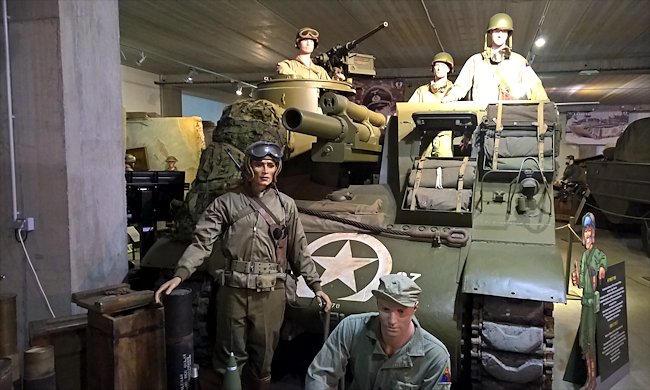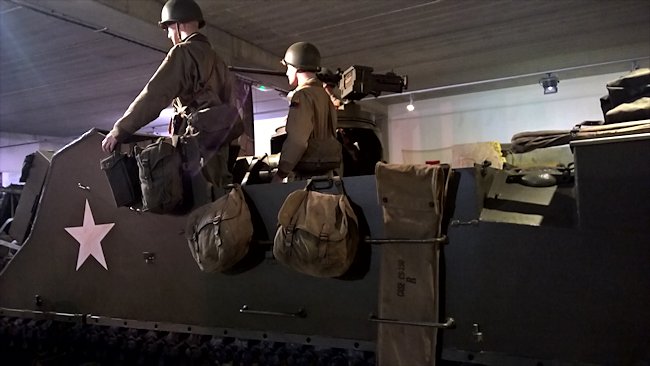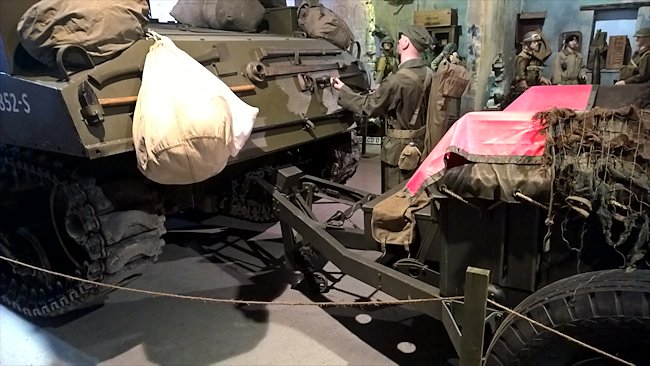M7B1 Priest 105mm SPG
M7 Priest 105mm Howitzer self-propelled artillery guns did land on the Normandy Beaches on D-Day but this M7B1 Priest in the Normandy Tank Museum only arrived in Europe at the very end of the War. It was purchased by the German Army and used in the Cold War.

M7B1 Priest 105mm Artillery SPG at the Normandy Tank Museum near Catz
Location
The Normandy Tank Museum is not hard to miss. It is next to the main N13 (E46) motorway. Set your Sat-Nav to the town of Catz in Normandy and then the road of La Fourchette or Rue de la Fourchette to be directed to the Museum entrance.
Specification
The M7B1 Priest was based on the M4A3 Sherman Tank. It powered by a Ford GAA all-aluminum 32-valve DOHC 60-degree V8 petrol engine which produced 525 hp. It had a top road speed of 24mph (39 km/h) but only 15mph (24 km/h) off road. Its armour thickness ranged from 12mm to 62 mm. The M7 was not designed to be at the front of a battlefield battling tanks. Its armour was only thick enough to protect the crew from small arms fire and shrapnel from exploding enemy rocket, mortar and artillery fire.
Its main gun was a 105 mm artillery howitzer that could fire high explosive HE shells 7 miles (11.27 km). As you can see from the photograph below the M7 Priest was also fitted with a 0.50 inch (12.7mm) M2 Browning Machine gun in the pulpit. The Priest could carry 69 shells. Some of these would be smoke rounds and a few armour piercing rounds for close protection if they were surprised by an enemy tank.

The M7B1 Priest SPG had a .50cal machine gun fixed to the rim of the pulpit tower.
The Normandy Tank Museum's M7B1 Priest's history
In the early 1970s this Priest was decommissioned from active service and went to the German Proving ground in Munster where it was used to teach new drivers how to tow. When not in use it was kept inside a tank hanger and maintained by the Army.
When it was purchased by the Normandy Tank Museum they asked the Dutch military vehicle restoration company BAIV BV to convert the M7B2 Priest back to the same condition it was when it came out of the Factory doors as a M7B1 Priest Self-propelled Artillery Gun. The major restoration work was the reinstatement of the M7B1 gun shield and the machine gun mount.

M7B1 Priest self-propelled artillery gun needed a five man crew
The development of the M7 Priest
The American Locomotive Company had already tooled up its factory to begin building the M7 Howitzer Motor Gun Carriage and using the assembly-line technique had produced sufficient vehicles to allow another ninety to be sent out as replacements for those lost on their way to the British Army. These guns were sent by convoy and in September 1942 were handed over to units in the front line, including the 11th Regiment Royal Horse Artillery, which was serving with the 1st Armoured Division.
Only two months later, in November, the 5th Regiment Royal Horse Artillery, also serving with the 1st Armoured Division, deployed their M7 105mm self-propelled artillery guns and used them to engage and destroy German anti-tank guns, which had been well dug in to fire at British tanks during the final battles of El Alamein. The gunners of the Royal Artillery were impressed with the new American guns, and, typically for the British Army, nicknamed the gun 'Priest' because of the mounting for the 12.7mm heavy machine gun in a pulpit like armoured tower.
In view of its success in battle the British Tank Commission in America requested that a further 5,500 M7 Priest SPGS be delivered by the end of 1943. Even with all its industrial might this was an optimistic request for America's armaments industry and it was realised that there was no way that this number of guns could be supplied to the British Army as well as those of the US Army, especially after events in December 1941. In the end the actual numbers entering service with the British Army would fall short of the requested amount.

M7B1 Priest SPGs also towed trailers loaded with supplies and ammunition.
Self-propelled artillery guns had been proven in earlier battles, but what made the M7 Priest So special was the fact that it was the first such design of any significance to enter service with the Allies. The M7 had actually come into being as a result of experiments to mount a 75mm howitzer on the chassis of a light tank in order to produce an SPG.
This was very much the same way that Germany had produced the anti-tank Panzerjager 1 SPG, with a 47mm gun mounted on the chassis of a panzer I tank in 1940. Another series of trials involved a 105mm-calibre gun being mounted on the chassis of an M3 Lee-Grant medium tank, which was in series production at the time and was used by the British Army. From these trials it was decided to develop the M7 using the chassis of the M4 Sherman as opposed to the lighter M3 medium tank.
During the development phase the basic system initially comprised an MIA 1 105mm howitzer on its standard field mount being mounted on to a modified M4 medium tank with an open top and high-sided superstructure. The early production run of the M7 was based on the M3 medium tank chassis but it was supplanted by using the chassis of the M4A3 Sherman.
The M7, as based on the M4 chassis, was 19ft 9in long, 9ft 5in wide and 9ft 7in to the top of the machine-gun mounting in the 'pulpit'. To the right-hand side of the superstructure was a ring mount for a .50in-calibre machine gun. This stood proud from the hull and, with its armoured covering, looked not unlike the pulpit in a church, thereby leading to the term 'Priest', which soon gained widespread use.
The M7 was powered by a Continental Model R-975-C 1, nine-cylinder radial petrol engine which developed 350hp at 2,400rpm to produce a maximum road speed of 26mph and 15mph cross-country. It had an operational range of 125 miles on roads and could scale vertical obstacles of 2ft high, cross gaps of over 7ft unaided and ford water obstacles of 4ft deep.
The entire series of M7 vehicles, including variants, was armed with a single 105mm howitzer for which sixty-nine rounds were carried ready to use. For close defence and protection against low-flying aircraft, there was a single .50in-calibre machine gun, for which 300 rounds were carried. The main armament could elevate between -5 degrees and +35 degrees and had a traverse capability of 15 degrees right of centre line and 30 degrees left of centre line to give a 45-degree traverse in total without the requirement of having to move the vehicle's position.
The problem causing the limited amount of traverse to the right was due to the fact that the driver's position to the left of the hull was in line with the breech mechanism as the weapon was moved. The M7 was protected by armour varying in thickness between 12mm and 60mm, and the vehicle had a combat-ready weight of 22.6 tons. It was served by a crew of seven men who operated in an open-topped fighting compartment and only the driver's position was under armour in the front of the hull.
The arrival of the M7B1 and M7B2 Priest
With the introduction of the M7B1 version, and as production numbers increased, the Pressed Steel Company was engaged to maintain output, but the American Locomotive Company remained the main producer and built 3,314 M7s. The Pressed Steel Company produced 826 M7s of which around 450 were the M7B1 version.
The only real difference between the original M7 and the M7B1 version was that the later design was slightly lighter. Some of this was due to the different engine, a Ford GAA V-8 that developed 450hp at 2,600rpm and achieved slightly reduced road speeds. The M7B1 version had a combat-ready weight of 22.3 tons and obstacle clearances were virtually identical to those capable with the M7.
The traverse and elevation of the main armament was unaltered and could fire high-explosive rounds out to ranges of almost 11,000yd and other types of ammunition to ranges of around 11,500yd. The M7B1 was still served by a crew of seven men, as was the third version, known as the M7B2. Only 127 versions of this model were built by the Federal Machine and Welder Company, giving a total wartime production of 4,267 M7s of all types. The only real difference between this last version and the two preceding versions was the fact that the machine-gun 'pulpit' stood slightly higher.
The British Army eventually developed a comparable SPG based on the Canadian-built Ram Cruiser tank, which mounted a 25-pounder gun and was known as the Sexton SPG. This break in use allowed the Americans to be supplied with all stocks of 105mm ammunition and in turn made logistical re-supply in the British Army much easier.
D-Day 1944 books

